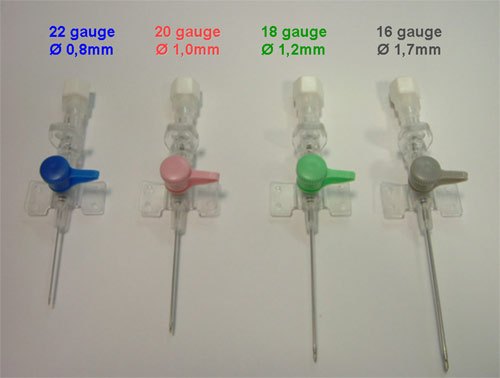💉 Venous access is one of the most common and high-yield OSCE skills. Be systematic, maintain asepsis, and communicate clearly with the patient.
📖 Introduction
- IV access is essential in emergencies. Seek senior guidance if multiple failed attempts, or if escalation to palliative care may be more appropriate.
- 🔑 In hypovolaemic patients: avoid wasting time with small veins; use two 18G (green) cannulas to initiate fluid resuscitation.
- ⚠️ Femoral vein access (most medial in femoral triangle) offers robust access but has high infection risk → daily inspection required.
- 💡 Flow rate ∝ (cannula radius⁴ / length). → Larger, shorter cannulas = faster flow (critical in trauma or shock).
- 🖥️ Ultrasound guidance: useful in difficult-access patients.
📌 Central Lines
- Useful for irritant drugs (e.g. chemotherapy, vasopressors) or CVP monitoring.
- 🚫 Not suitable for rapid fluid resuscitation (slower flow rates than large-bore peripheral lines).
- Preferred sites: Internal jugular (compressible), Subclavian (clean but non-compressible), Femoral (easiest, but dirtiest).
- Ultrasound guidance significantly reduces complications.
📝 Procedure Introduction (OSCE style)
- ✅ Wash hands, introduce yourself, check ID, gain verbal consent.
- Check for allergies (esp. chlorhexidine/latex) & AV fistulas.
- If patient lacks capacity → act in best interests in emergency.
- Ensure name badge visible, chaperone if appropriate.
🛠️ Equipment
- Sterile gloves, apron, tourniquet, alcohol wipes
- IV cannula (choose gauge according to purpose)
- 10 ml saline flush, dressing (Tegaderm), sharps bin
🎨 Choosing the Cannula
| Color | Size | Flow Rate | Common Uses |
|---|---|---|---|
| 🟡 Yellow | 24G | 13 ml/min | Paediatrics, fragile veins, chemo |
| 🔵 Blue | 22G | 31 ml/min | Small/fragile veins |
| 🩷 Pink | 20G | 67 ml/min | Antibiotics, maintenance fluids |
| 🟢 Green | 18G | 103 ml/min | Blood products, resus fluids |
| ⚪ Grey | 16G | 236 ml/min | Trauma, major surgery |
| 🟠 Orange | 14G | 270 ml/min | Major trauma, rapid transfusion |

🩺 Technique
- Apply tourniquet, palpate for suitable vein (forearm > hand > snuffbox).
- Clean skin, warn patient: "sharp scratch".
- Insert at 15–30° angle until flashback seen → advance plastic cannula off needle.
- Release tourniquet, remove needle safely, secure with dressing.
- Flush with saline to check patency → look for swelling/leakage.
📌 General Advice
- Prefer upper limbs over lower limbs.
- Work distal → proximal.
- Avoid dominant arm & limbs with dialysis fistulas.
- Replace lower limb cannulas ASAP.
⚠️ Complications
- ❌ Failed attempt (max 2–3 tries → call senior).
- 💢 Haematoma (remove tourniquet before needle withdrawal).
- 🩸 Arterial puncture (apply firm pressure, don’t reuse site).
- 🔥 Phlebitis/extravasation (esp. with irritant drugs).
- 🦠 Local infection/cellulitis, rare septicaemia.
- 🫁 Air embolism if line not flushed/secured properly.
💡 Top OSCE Tips
- Smile, reassure, explain each step clearly.
- Verbally confirm vein chosen, and check sharps bin location.
- Always flush and check patency before leaving.
- State escalation plan: "If unsuccessful after 2 attempts, I’d ask a senior/anaesthetist for assistance."